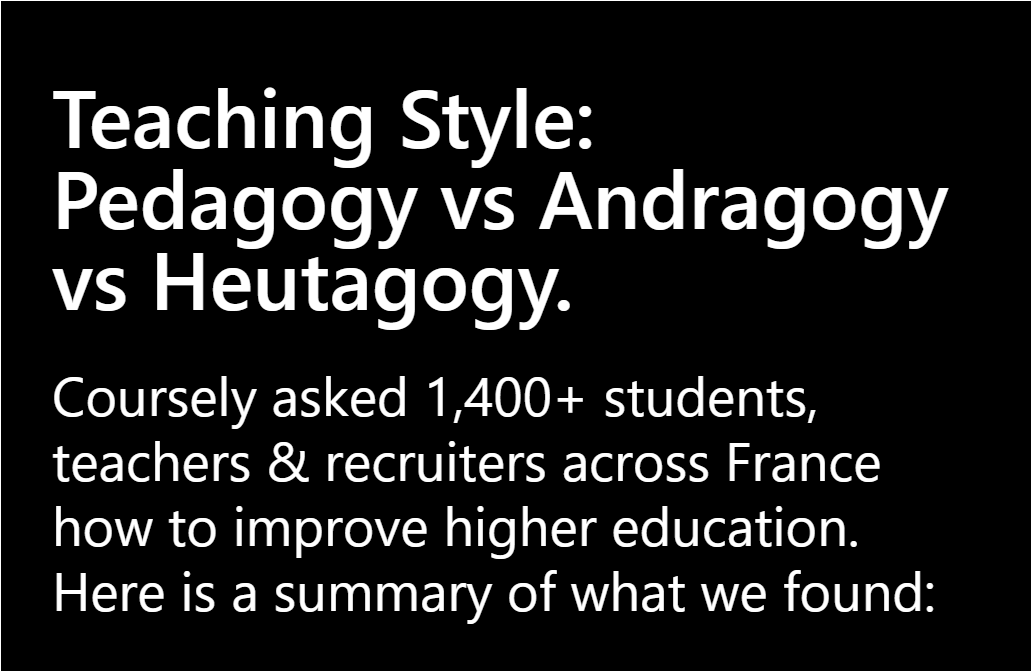Teaching Style: Pedagogy vs Andragogy vs Heutagogy.
Coursely asked 1,400+ students, teachers & recruiters across France how to improve higher education. Here is a summary of what we found:
| Level of Dependence | Pedadogy: teaching children who are dependent upon their teacher Andragogy: teaching adults who are striving for autonomy Heutagogy: teaching autonomous self-learners Our findings: Students want to be treated as autonomous adults, however tend to be ill-prepared for the transition from lower education’s traditional, pedagogical approach to the professional world’s andragogical and heutagogical expectations. Teachers are pushed by universities to use non-traditional teaching methods, however classrooms tend to be designed for a traditional pedigogical approach. As a result, students prefer internships & work-study programs over classroom learning because they are treated as working professionals and for the responsibility and real world, on-the-job training. Related responses: Student Satisfaction, Course Content, Student ‘Failure’ vs Success, Wicked vs Kind Environments |
| Access to Resources | Pedadogy: learner is fully dependent on teacher for content and direction Andragogy: learner has resources and autonomy and learns through their’s and other’s experience Heutagogy: learner has resources and autonomy and learner decides direction Our findings: Students today have immediate, unregulated access to so many resources that they tend to suffer from information overload, and prefer multi-tasking than concentrating on one task at a time. Students tend to be unable to distinguish reliable from unreliable sources, and prefer short, concise, easy-to-consume content over more challenging, high-quality information in long form. Related responses: Course Content, Workload Expectations, Student ‘Failure’ vs Success |
| Learning Intentions | Pedadogy: linear, organized learning required to progress to next stage in life/career Andragogy: linear, organized learning required to improve in current stage in life/career Heutagogy: non-linear, unplanned learning based on identified needs and potential Our findings: Students polled prefer the non-linear, multi-tasking learning challenge offered in internships and work-study programs and prefer their classroom experience to be predictable, organized, and practical; designed to help them be successful in their internships and work-study program. Related responses: Career Preparation, Teacher Recruiting, Wicked vs Kind Environments |
| Learning Focus | Pedadogy: sequential, structured learning based on subjects and following an enforced curriculum Andragogy: task-centric or problem-centric learning Heutagogy: pro-actively avoid problems by learning from own and others’ experiences Our findings: students polled want practical learning in the classroom designed to help them excel in the working world. Depending on university accreditations, curriculum syllabi with comprehensive content and testing standards are enforced, putting teachers in the difficult position of managing contradictory student and university expectations. Related responses: Teacher Recruiting, Career Preparation, Course Content, Wicked vs Kind Environments |
| Motivation for Learning | Pedadogy: externally motivated Andragogy: internally motivated Heutagogy: internally motivated Our findings: students polled want both short-term gain and long-term advantage, and tend to be disappointed by their academic experience, which resorts to external motivation up to threats of academic failure if the student does not ‘do what the teacher says’. Related responses: Career Preparation, Student Satisfaction, Course Content, Student ‘Failure’ vs Success |
| Teacher’s Role in Learning | Pedadogy: teacher designs and imposes learning process and content Andragogy: teacher creates environment that encourages self-learning Heutagogy: teacher manages autodidact’s learning environment Our findings: learning during internships and work-study programs involve being paid to perform autonomous and collaborative projects with deadlines, and hands on training and personalized feedback from colleagues when the student has questions. Employers can monetize student output, thus employers have a vested interest in the student’s success. Conversely, learning in universities involve students paying to be grouped into traditional classrooms and obliged to prioritize theory taught by a teacher where the students know their output will receive little personalized feedback, will most likely be deleted at the end of the semester, and has no legitimate place on their CV. Related responses: Course Content, Workload Expectations, Student Satisfaction, Wicked vs Kind Environments |

